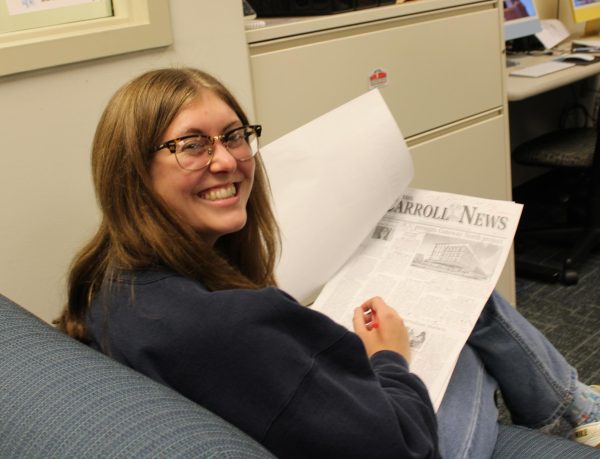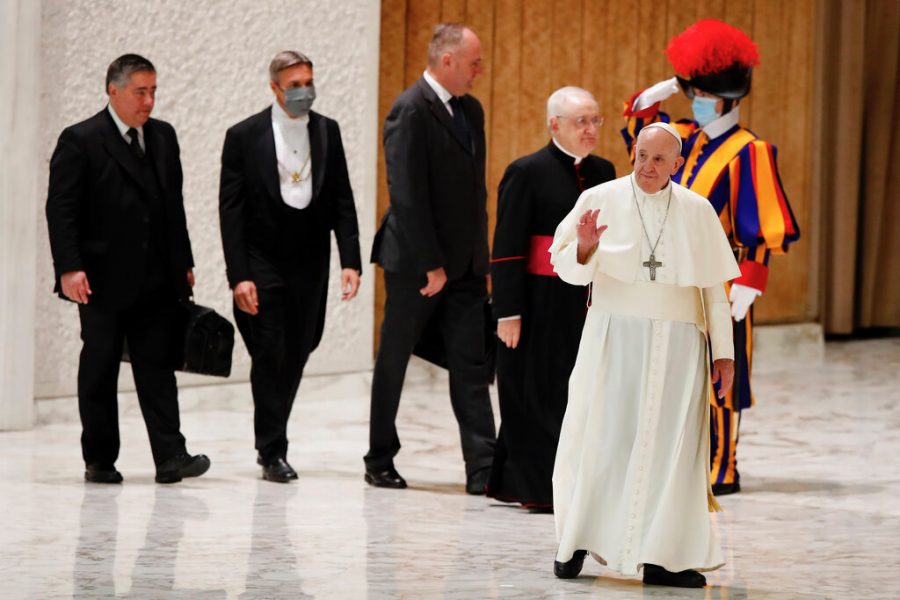Women should be priests
Pope Francis arrives in the Paul VI Hall at the Vatican for his weekly general audience, Wednesday, Oct. 28, 2020. Pope Francis has blamed “this lady COVID” for forcing him to keep his distance from the faithful during his general audience, which was far smaller than usual amid soaring coronavirus infections in Italy. (AP Photo/Alessandra Tarantino)
For centuries, the Catholic Church has prohibited women from fully participating in the faith based on controlling patriarchal tradition and gendered power dynamics.
In 16th century England, in the midst of the Reformation, women were given limited public voice. Their writings, if published, were not respected or seriously considered, according to the “Norton Anthology of English Literature.” The constrained social space that women of that era occupied was due to men dictating biblical interpretations, from which they determined that women were the subordinate gender.
Many women, unable to read scripture and challenge men’s interpretation of the Bible, assumed the position men had created for them. These constraints were only aggravated by the closure of monastic spaces after the Reformation — some of the few places women could become educated and study scripture for themselves.
Acceptable positions for women were narrowly limited to marriage and religious life. This forced many women to work within the constraints of their gender. An essay by Wendy Wall, professor at Northwestern University, notes the example of the Cooke sisters, who used the acceptable female pastime of religious study to create influential translations that clarified ambiguous parts of doctrine and even “furthered the consolidation of England,” according to Wall.
Wall also discussed Isabella Whitney, who presented her writings in the form of a medicinal recipe. As Wall’s examples demonstrate, women found clever ways to function within their constraints, ultimately securing more freedom from the suffocating measures the patriarchy enforced.
Queen Elizabeth functioned similarly. During her ascension to the throne, there was a widespread conviction that women were unsuited to hold power over men. Elizabeth pushed back against this criticism by citing the king’s “two bodies.” The king of England was said to have both a mortal body and an immortal political body, which was timeless and perfect. Thus, with her immortal political body she could overcome her feminine tendencies. Elizabeth used English tradition to legitimize her claim to the throne. She was forced to function within gender stereotypes even as the Queen.
For years, the Catholic Church has made space for men to enforce toxic power structures that limit women’s roles and education. Though the Bible does not mention that women can’t be priests, it was interpreted in that way by men. Many cite this interpretation as a reason to prohibit women from joining the priesthood, saying it would go against tradition to ordain women, yet this tradition was created by men for their benefit.
By limiting the priesthood to men, the Catholic Church is stating that women are not able to have the same relationship with God or with a congregation as men. This perpetuates the false notion that women and men are intellectually and spiritually different. Additionally, it reinforces gender as a governing factor in the capabilities of individuals.
Women are as capable, as intelligent, as religiously endowed as men. For centuries, the institution of the Catholic Church has been weaponized to oppress and constrain women. The persisting doctrinal limitations of women are remnants of the male-dominated interpretation of canon that prevailed from the 12th to the 16th centuries.
Genesis 1:27 states that “humankind was created as God’s reflection: in the divine image God created them, female and male, God made them.” Female and male. Both are entitled to participate fully in the rites of the Catholic Church, regardless of their biological composition.










